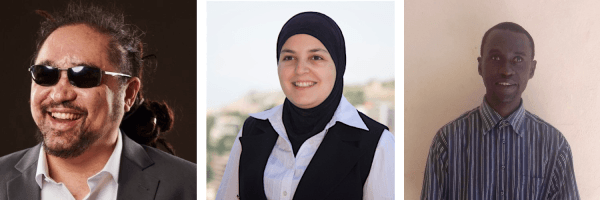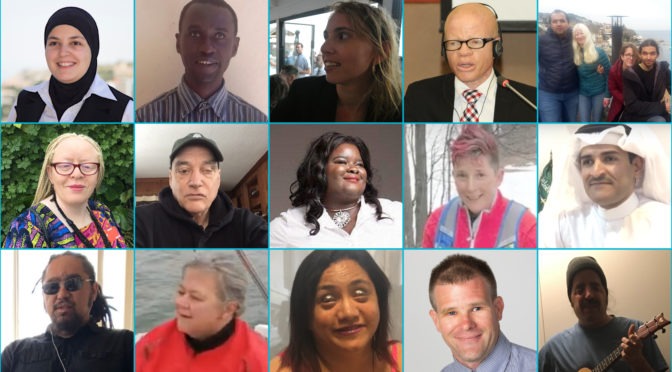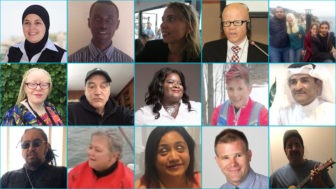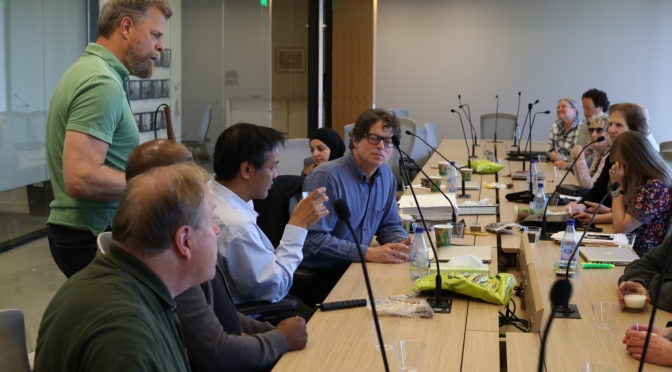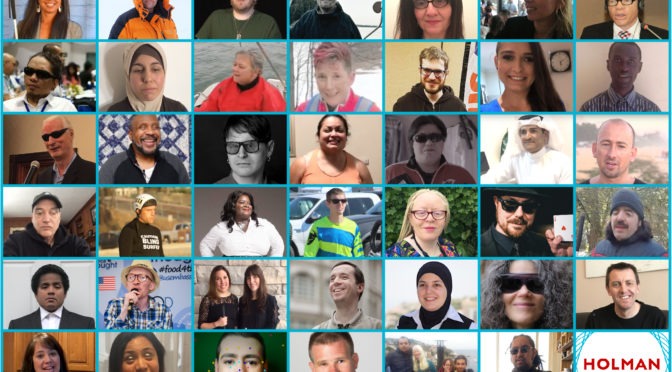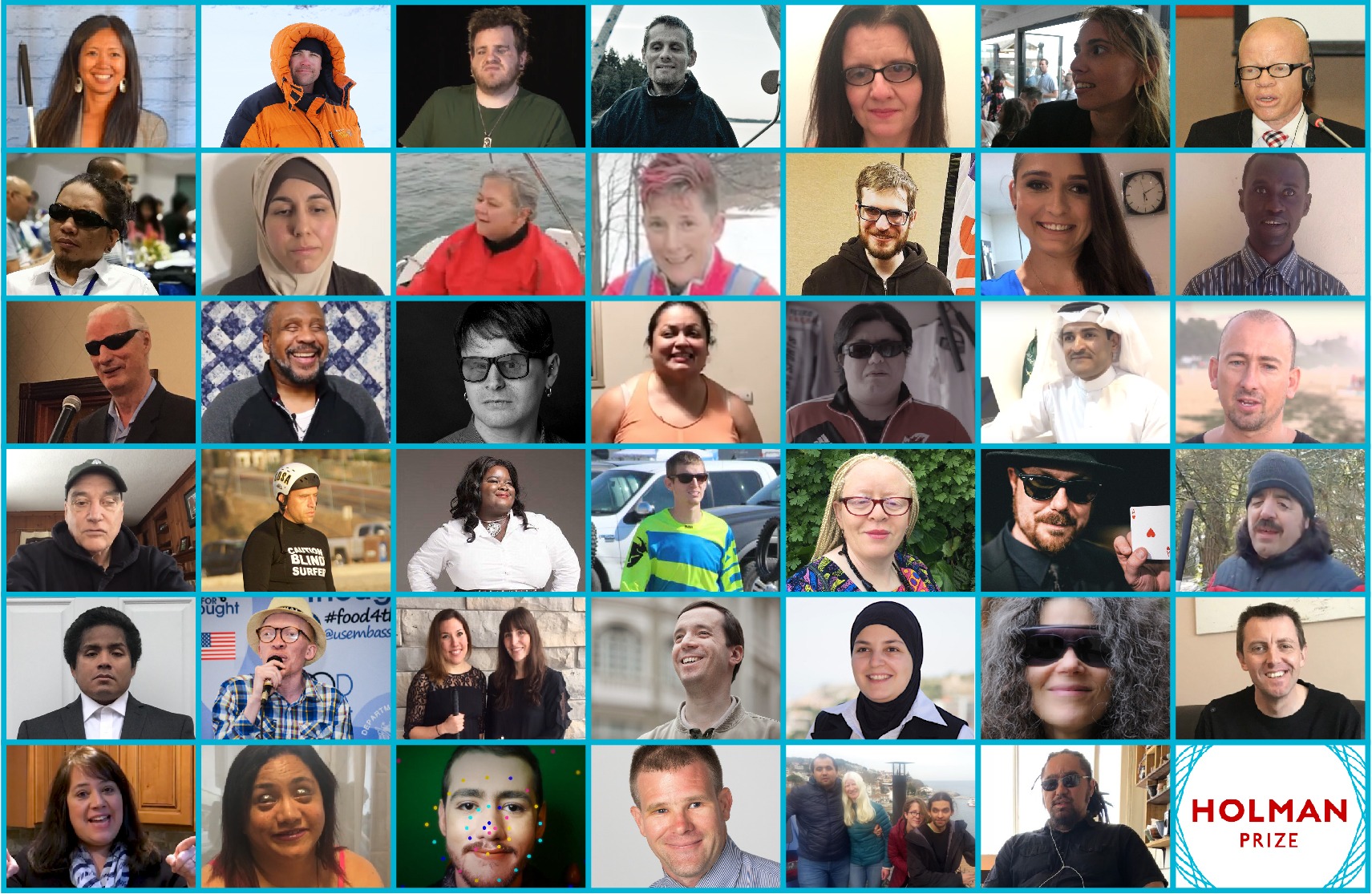In its third year, the Holman Prize for Blind Ambition received 111 applications from six continents. The semifinalists’ proposed projects are incredible, and highlight advocates, artists, athletes, entrepreneurs, and more. It won’t be an easy task to choose the three 2019 prizewinners from such a strong and diverse group.
The Holman Team is in the process of selecting finalists for the judging committee to select from, but in the meantime, we invite you to peruse the whole group of semifinalist submission videos to experience the diversity of people and proposals in the field.
This week, all semi-finalists have submitted their complete application packets, hundreds of pages of ambitious detail which will help them change the world’s perception of blindness. In just a few weeks, we’ll welcome our judges at LightHouse in San Francisco to review the finalists’ proposals and select the 2019 Holman prizewinners.
As always, the prestigious Holman judge panel represents a leading cross-section of blind talent and experience, a group devoted to the highest ideal of blindness, both personally and professionally.
Meet the Holman Committee:
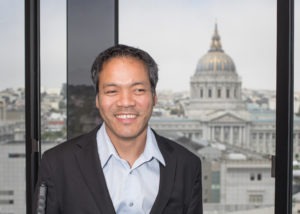
Jennison Asuncion, Engineering Manager, LinkedIn
“I lost my sight before I was two. So to me, being blind has always felt normal. It is part of me but does not define who I am.”
Jennison Asuncion moved to the Bay Area in November 2013 to lead LinkedIn’s digital accessibility efforts. Originally from Montreal, he has been working in digital accessibility for over ten years. In 2012, Jennison co-founded the annual Global Accessibility Awareness Day (GAAD). Held annually on the third Thursday of May, GAAD is dedicated to raising awareness of digital access and inclusion by and for the more than one billion people with disabilities. Jennison sits on the Board of Directors for the LightHouse for the Blind and Visually Impaired San Francisco, AMI (Accessible Media Inc.), and Knowbility.

Bryan Bashin, CEO LightHouse for the Blind and Visually Impaired
Bryan Bashin has led a diverse life since he graduated UC Berkeley in history and journalism. Mr. Bashin first spent 15 years as a journalist in television, radio and print, specializing in science news. In 1998 he was hired as Executive Director of the Sacramento Society for the Blind, where he quintupled the number of hours of teaching and developed innovative programs such as the Senior Intensive Retreat and summer immersion camps. In 2004, Mr. Bashin was hired as the Region IX assistant regional commissioner for the US Department of Education’s west coast branch of RSA, overseeing funding for $500 million in federal disability programs. In 2010 he was hired to lead the LightHouse for the Blind in San Francisco, where he works today with a staff of 140. Mr. Bashin is a relentless innovator, working with a remarkable idealistic staff. Throughout his career, Mr. Bashin has worked in the confluence of high technology, social advocacy and governmental partnerships.
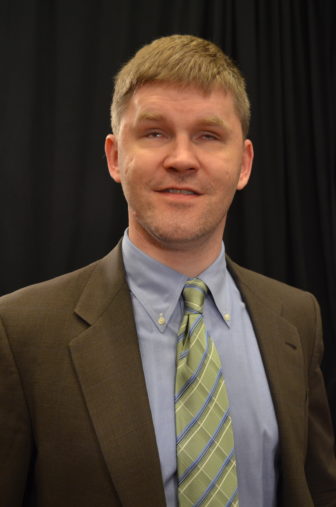
Eric Bridges, Executive Director, American Council of the Blind
“I believe that people who are blind or visually impaired should strive to be the best they can be, and I believe that each blind or visually impaired person has the right and responsibility to define success on his or her own terms.”
Eric joined the staff of the American Council of the Blind in 2007. In 2013, he became the Director of External Relations and Policy, cultivating many key relationships with business, industry, government officials, and agency staff. Two years later, the Board appointed him executive director. He is responsible for overseeing the daily operations of both of ACB’s offices.

Kerryann Ifill, President of the Senate, Barbados
“The art of living with blindness demands absolute creativity; creativity in attaining and maintaining your own independence, creativity in charting a path that encourages others to emulate your example, creativity in ensuring that others value and recognise your individuality and the right to be the whole person you were designed to be.”
Kerryann’s life continues to be characterized by landmarks. As the first totally blind student completing mainstream education to post graduate level; becoming the first female to hold the office of President of the Senate, the only person with a disability and the youngest person. She has served both professionally and personally in various organizations for persons with disabilities, both locally and regionally and currently hold the office of President of both my the National United Society of the Blind Barbados and the Caribbean Council for the Blind. She represented her country and at several local, regional and international fora on a cadre of issues related to disabilities. The Holman Prize embodies her belief that blindness is not a burden, but an exciting opportunity.

Anil Lewis, Executive Director, National Federation of the Blind Jernigan Institute
“Blindness is a paradigm shift.”
A passionate advocate for the rights, education and employment of blind people everywhere, Anil currently serves as the executive director of Blindness Initiatives for the National Federation of the Blind Jernigan Institute in Baltimore, MD, where he leads a dynamic team of individuals responsible for the creation, development, implementation, and replication of innovative projects and programs throughout a nationwide network of affiliates that work to positively affect the education, employment, and quality of life of all blind people.
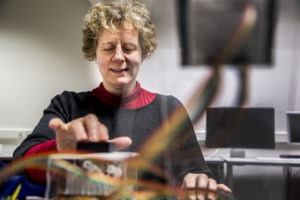
Dr. Sile O’Modhrain, Professor, University of Michigan
A professor in performing arts technology at the school of Music, Theatre and Dance at the University of Michigan, O’Modhrain brings a wide breadth of personal and professional skill to the Holman Prize committee. With past careers in sound engineering, technology, music and more – and passionate study in the fields of arts, assistive technology, and haptics – O’Modhrain is constantly in search of better ways for blind people to access information and work in the world.

Sassy Outwater-Wright, Executive Director, Massachusetts Association of the Blind
“There is no one right way to do vision loss. There is your way, and individuality is essential to accessibility. We’re writing history now, deciding how to combine technology and our own humanity to redefine what independence means to us as individuals who are part of the same community. Dignity, opportunity, innovation and accessibility feed off each other.”
Sassy is the executive director of the Massachusetts Association for the Blind and Visually impaired (MABVI). She lost her sight at 3 due to retinoblastoma, and has had several rounds of cancer since then. She is a passionate digital accessibility advocate, specializing in technology for people with multiple disabilities, and studying how intersectionality, artificial intelligence, and intersecting marginalizing factors affect people. She lives in the infamous Salem, Massachusetts, and it fits her perfectly.

Dr. Britt Raubenheimer, Senior Scientist, Woods Hole Oceanographic Institution
“Losing vision was a hurdle, but it forced me to grow. When I lost my sight I thought I would need to discontinue my work and many of my activities. But instead, overcoming my inability to see taught me self-confidence and encouraged me to explore.”
Britt is a senior scientist at Woods Hole Oceanographic Institution in Woods Hole, MA. Working with a team of other scientists, students, and engineers, she collects and analyzes measurements to understand interactions among coastal waves and surge, beach and dune evolution, groundwater, and winds and precipitation during extreme storms. When others evacuate before a hurricane, Britt often is on her way to the beach. Deploying her instruments in the ocean requires SCUBA, and Britt is the only legally blind, certified, university research diver. Britt resides in northern Idaho, where she serves on the board of the Idaho Commission for the Blind, and enjoys skiing, hiking, and knitting.
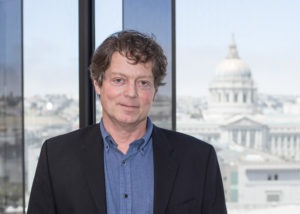
Jason Roberts, Author, ‘A Sense of the World’
An accomplished author, Roberts’ acclaimed work, about the intrepid blind traveler (and namesake of this prize) James Holman, “A Sense of the World: How a Blind Man Became History’s Greatest Traveler,” was a finalist for the 2006 National Book Critics Circle Award, long-listed for the international Guardian First Book Award, and named a Best Book of the Year by the Washington Post, the San Francisco Chronicle and Kirkus Reviews. Born in Southern California, Roberts earned his high school diploma at fourteen, then took a five-year hiatus from education. He worked as a day laborer, dishwasher and late-night disc jockey before matriculating at the University of California, Santa Cruz. He lives in Sausalito, California, with his wife, a chemical engineer, and their two young children.

Dr. Sharon Sacks, Retired Superintendent, California School for the Blind
Dr. Sacks is recently retired from her post as Superintendent of the California School for the Blind. During her tenure, Dr. Sacks led a staff of 150 and promoted education excellence for students served on campus and through outreach programs throughout the state. Prior to her role as superintendent, Dr. Sacks was the Director of Curriculum, Assessment, & Staff Development at CSB. After receiving her doctorate, Sharon coordinated programs, and was a university professor in moderate/severe disabilities at San Jose State University, and programs in visual impairments at California State University, Los Angeles. Dr. Sacks worked as a TVI for eight years as a resource and itinerant teacher prior to assuming leadership positions.
Dr. Sacks is a strong advocate for ensuring quality services for children and adults who are blind or visually impaired through her direct work with families, consumer organizations, and professional organizations. She is the recipient of the Mary K. Bauman Award for Distinguished Service in Education, and a past president of AERBVI. Dr. Sacks currently serves on the Lighthouse’s Board of Directors.

Dr. Zach Shore, Historian
A historian of international conflict, Dr. Shore is the author of five books, including “A Sense of the Enemy.” Shore is Associate Professor of History at the Naval Postgraduate School and Senior Fellow at the Institute of European Studies, University of California, Berkeley. He earned his doctorate in modern history at Oxford, performed postdoctoral research at Harvard, and held a fellowship at Stanford’s Center for Advanced Study in the Behavioral Sciences.
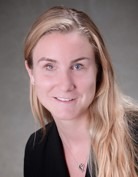
Kathryn Webster, President, National Association of Blind Students
“Though a single inconvenience, blindness has the power to ignite strength, resilience, and confidence. We may grow exhausted of educating society of our abilities, but who more qualified than blind communities to shatter the glass ceiling that eternally perpetuates negative misconceptions?”
Kathryn graduated from Wake Forest University with high honors, receiving Bachelor of Science degrees in Statistics and Computer Science in 2017. Her scholastic achievements propelled her into a career with Deloitte & Touché, LLP where she specializes in strategic transformation and data analytics. Kathryn recognizes the value in intertwining corporate prowess with civic engagement, thus jumpstarting a statewide transition program for blind and low vision youth, designed to ignite confidence and independence, demonstrate the value of mentorship, and encourage Virginia’s youth to shoot for the stars. Kathryn proudly serves as President of the National Association of Blind Students (NABS), Kathryn lives each day with true authenticity, bringing difficult conversations to the table and engaging in a persistent challenge to be the best version of herself.

Holly Scott-Gardner, Blindness Advocate and Blogger
“I view my blindness as an integral part of who I am. It has shaped my experiences and more often than not presented me with opportunities I don’t believe I would have had if I could see. The so-called difficulties of blindness more often than not result from a world that is not built with blindness in mind. Whether I’m faced with an inaccessible payment terminal, or a stranger who insists I shouldn’t cross the street alone, I am wrestling with an inaccessible world and the misinformed views many hold on blindness. My blindness isn’t the thing that needs to be changed.”
Holly is a public speaker, blindness advocate and Youtube creator in the U.K. When Holly was still a teenager in school, she realized that she could use her voice and experiences to change how blindness is viewed. Eight years after setting up her blog she has spoken in Parliament, lobbying the government to alter its provisions for disabled students, advocated for the rights of disabled survivors of domestic abuse at the European Parliament in Brussels and represented disabled students at her university by winning the seat of disabled students counsellor. She aims to ramp up her advocacy work after graduation, with an outlook on international blindness movements. Read Holly’s essay about her experience as a camp counselor at Enchanted Hills Camp.

Ahmet Ustunel, Teacher of the Blind and Visually Impaired and 2017 Holman Prizewinner
“As a blind person to educate the public about blindness and as an educator to inspire my Blind students, I am trying to foster the same qualities Holman demonstrated: immense courage and passion, persistence, a curious and adventurous spirit, strength of purpose, and belief in one’s self. As a blind teacher of blind students, I tell my students that being blind should never prevent them from achieving their goals, although they might need to deal with prejudices, discrimination, and an inaccessible physical and educational environment. I let them know that limits and barriers they encounter are not results of blindness itself; they are just products of prejudice and discrimination in society. Even worse, sometimes they are our own mind’s products. I want my students to understand blindness as a characteristic of a person rather than a limitation.”
Ahmet is a full-time teacher of the visually impaired in San Francisco. He is also an avid outdoorsman and one of the inaugural recipients of the Holman Prize for Blind Ambition. He began solo kayaking in San Francisco Bay shortly after moving to the United States from Turkey a decade ago. With the Holman Prize, Ahmet achieved his ambitious goal in July 2018 by paddling across the Bosphorus Strait, which divides the European region of Turkey from its Asian counterpart, completely alone. Read about his solo kayaking journey from Europe to Asia.


